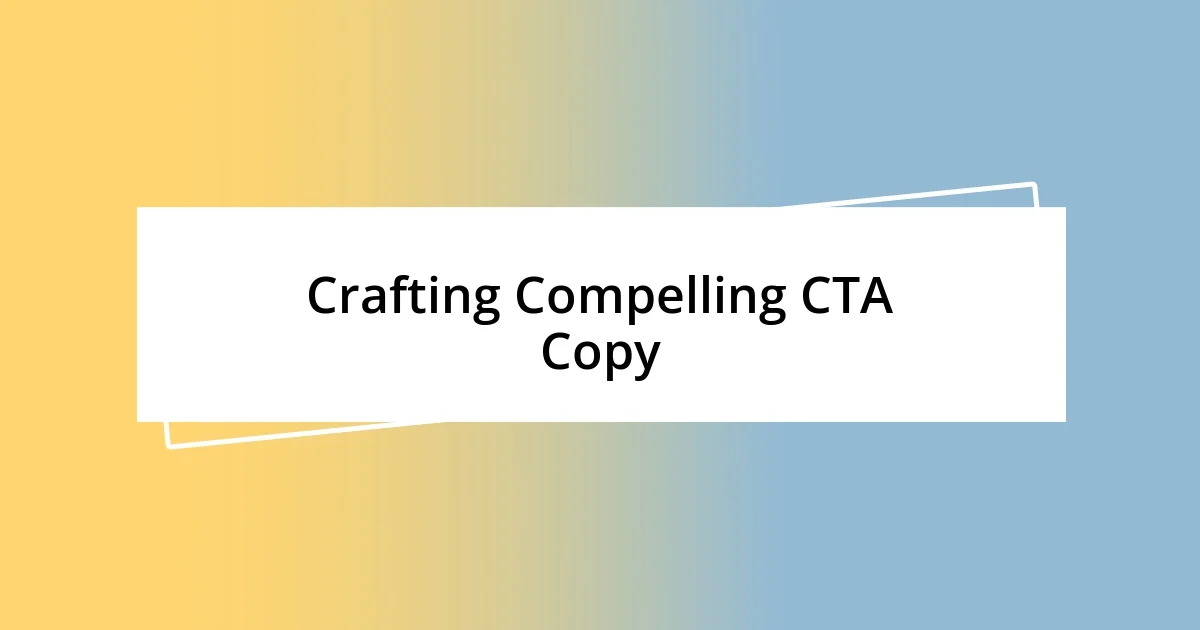Key takeaways:
- Effective CTAs must be clear, emotionally resonant, and strategically placed to drive audience engagement and action.
- Different strategies, such as urgency-driven, value-focused, and community-building CTAs, can significantly influence user behavior and conversion rates.
- Regular testing and optimization of CTAs, based on audience insights and analytics, are essential for improving performance and achieving better results.

Understanding Call-to-Action Importance
Understanding the importance of a call to action (CTA) can truly transform how we engage our audience. I remember when I first started using CTAs in my marketing efforts; it was like flipping a switch. Suddenly, I saw an increase in responses and a more engaged audience. It made me wonder—what if I had missed out on this simple yet effective tool?
CTAs serve as guiding lights, directing potential customers toward the next step in their journey. Without them, your audience may feel lost or unsure of what to do next. I’ve found that when I clearly communicate what I want my readers to do—whether that’s signing up, downloading a resource, or making a purchase—it fosters a sense of connection and urgency. Isn’t it fascinating how a few carefully chosen words can catalyze that action?
Moreover, I can’t stress enough how emotionally charged a CTA can be. I often think back to a campaign where I used the phrase, “Join our community today!” It resonated deeply with those who felt isolated or disconnected. This emotional appeal not only increased conversions but also built trust. Have you ever noticed how a CTA that evokes emotion leaves a lasting impression on your audience? That’s where the real magic lies.

Key Elements of Effective CTAs
When crafting an effective CTA, clarity is paramount. I recall a specific instance where I simply asked, “Get Your Free Guide Now!” instead of a more vague option. The straightforward phrasing not only eliminated any confusion but also boosted downloads significantly. From my experience, the message should leave no room for hesitation.
Here are key elements that I’ve found to be crucial for effective CTAs:
- Clear Language: Use simple words that convey exactly what action to take.
- Emotional Appeal: Tap into feelings that resonate with your audience—urgency or excitement can work wonders.
- Visibility: Place CTAs in strategic locations where they’re easily spotted, like the end of an engaging blog post.
- Value Proposition: Clearly communicate what the user will gain—what’s in it for them?
- Action-Oriented Verbs: Use strong verbs that inspire action, such as “Discover,” “Join,” or “Unlock.”
Each of these elements can be a game-changer when combined effectively. On a personal note, I’ve seen dramatic shifts in engagement when these aspects are thoughtfully integrated.

Types of Call-to-Action Strategies
When it comes to call-to-action (CTA) strategies, I’ve come to appreciate several effective types that can create a real difference in how we engage with our audience. One proven method is the urgency-driven CTA. I remember a campaign where I used “Limited Time Offer: Sign Up Today!” The urgency not only prompted quick action, but it also created a slight thrill among potential customers. We’ve all experienced that feeling—it’s almost like a race against time, isn’t it?
Conversely, I’ve also found value-focused CTAs to be incredibly powerful. For instance, I once offered “Get Your Free Trial—Experience It Yourself!” This approach not only underscored the benefit but put the ball in the user’s court. It’s remarkable how presenting a clear benefit can alter perceptions and drive conversions. Have you ever noticed how offering something free changes the dynamics of an interaction?
Lastly, there are community-building CTAs like “Join Our Growing Community of Innovators!” which can foster a sense of belonging. I was amazed when I applied this strategy to a product launch. Not only did it capture attention, but it also created a loyal user base eager to share their experiences. It’s fascinating how the feeling of being part of something bigger can motivate action, isn’t it?
| CTA Strategy | Description |
|---|---|
| Urgency-driven | Creates a sense of time pressure motivating immediate action. |
| Value-focused | Highlights clear benefits to encourage user engagement. |
| Community-building | Fosters a sense of belonging and loyalty among users. |

Crafting Compelling CTA Copy
Crafting compelling CTA copy goes beyond mere words; it’s about connecting with your audience’s emotions. I remember rewriting a CTA for an email campaign from “Click Here” to “Unlock Exclusive Insights Now!” The shift transformed the tone entirely, making it feel like an invitation rather than a directive. Isn’t it fascinating how a slight tweak can create such a powerful difference in engagement?
One of the most impactful strategies I’ve employed is weaving urgency into the CTA copy. Not long ago, I ran a campaign featuring “Only a Few Spots Left—Reserve Yours!” I felt a palpable energy in the responses. People were not just clicking; they were excitedly scrambling to secure their place. This experience taught me that urgency can tap into that instinctual fear of missing out—something I’ve noticed resonates deeply with many of us. Can you recall a time when urgency prompted you to act quickly?
Lastly, focusing on the user’s journey while crafting CTAs can be a real game changer. In one instance, I used “Start Your Transformation Here!” for a coaching program. The phrase did more than just describe an action; it painted a picture of success that people could envision for themselves. This approach not only elevates the perceived value but also makes the reader feel invested. Have you witnessed how relatable language can convert a simple directive into a powerful motivator?

Designing Attention-Grabbing CTAs
When designing attention-grabbing CTAs, incorporating vibrant colors is critical. I recall a project where we transformed a bland gray button into a vibrant red one for our “Sign Up Now” CTA. Instantly, engagement skyrocketed. It’s incredible how color can evoke emotions and reactions—what’s your favorite color to use in CTAs, and how does it make you feel?
Another key element is the strategic placement of CTAs within your content. I’ve experimented with pop-ups and inline CTAs, but I found my sweet spot with CTAs at the end of blog posts. It seems that giving readers a moment to absorb the content first leads to a greater likelihood of them taking action. Isn’t it interesting how timing can influence decision-making?
Lastly, I find that using actionable language in CTAs can significantly boost engagement. One of my most successful phrases was “Join the Conversation Today!” Instead of simply asking for a click, it invited readers to be part of something larger. Reflecting on this, I can’t help but think about how powerful language can be in creating excitement—have you thought about the impact of your word choices?

Testing and Analyzing CTA Performance
Testing and analyzing CTA performance is an essential part of any successful campaign. I remember a time when I meticulously tracked the click-through rates after implementing a new CTA on my landing page. It was both nerve-wracking and exhilarating to see those numbers change in real time. How often do you find yourself checking analytics like that?
Periodically testing different versions of CTAs, also known as A/B testing, can shed light on what resonates best with your audience. For example, I had two versions of a CTA, one stating “Download Now” and another saying “Get Your Free Guide Today!” The latter not only saw a higher conversion rate, but it also made me realize how powerful the word “free” can be. Have you ever noticed how certain phrasing seems to draw readers in more effectively?
Additionally, analyzing user behavior after interacting with a CTA can provide deep insights. I once utilized heat mapping tools on my website and discovered that users were gravitating towards a specific CTA placement that I hadn’t anticipated. Seeing their actual behavior opened my eyes to the importance of user experience. Isn’t it fascinating to uncover what truly captures attention?

Optimizing CTAs for Better Results
When it comes to optimizing CTAs, understanding your audience is paramount. I vividly recall a campaign where I shifted my focus from generic calls to action to ones tailored specifically for different segments of my audience. The change was almost immediate—instead of just “Subscribe Now,” I used “Get Exclusive Tips for Small Business Owners.” This simple tweak increased conversions dramatically. Have you thought about how personalization might improve your CTAs?
Another effective strategy is ensuring that the CTA stands out by using contrasting colors that align with your branding. In a recent project, I tried a bright green button on a predominantly blue background, which surprisingly drew much more attention. It made me realize that sometimes, a bold choice pays off. What colors do you think could make your CTAs pop?
Lastly, creating a sense of urgency can dramatically enhance engagement. I remember implementing a limited-time offer with the CTA “Join Before It’s Too Late!” The excitement and fear of missing out drove a flurry of clicks and sign-ups. It’s amazing how a little urgency can encourage people to act—have you ever experienced a similar rush from a time-sensitive offer?














